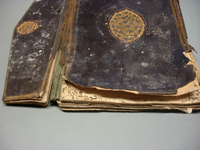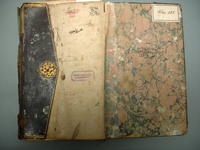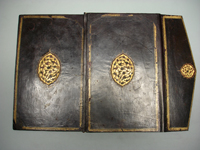Book adoption
The work on book adoption is also an important area for the Institute. Books, prints or photographs „adopted“ by patrons are conserved. That may entail conservation of individual books or preventive measures for whole groups of holdings.
For example: thanks to the Gutenberg 3000 Initiative the total holdings of incubulae (8,000) of the Austrian National Library were stored in acid-free envelopes and boxes.
Further information
Conservation of Codex Glaser 123
|
ConditionThe codex was in general badly preserved, and because of previous damage done by water the binding was deformed and covered with mould. The cardboard cover had, as a result of the effect of the water, split up into layers of paper.The leather binding had blemishes and tears and damage due to previous restorations. The sewing, spine lining, and headband were damaged and in a very sorry state. In the book block there were insect dung and bitemarks, and many tears and losses of the paper support. The binding was covered by two different pieces of goat leather and was done in the Turkish style „Den-Dann“; the leather circling the medallion was painted with a bright wine-red and gold. The covers are framed with golden borders. A smaller motif in the same style was worked into the flap “Mikleb”. Treatment reportBoth covers were removed from the spine, the quires and leaves taken a part, and dry cleaned.Leaves with water spots were cleaned in situ with methyl cellulose and cotton wool buds. Several leaves and the paste down were disinfected with a 70% ethanol-water mixture. The edges of every page were resized with methyl cellulose, and tears mended and losses infilled with Japanese paper. Finally all the leaves were flattened once more by spraying with and ethanol-water mixture and then drying under weight. The sections were assembled again and the book block was sewn once more in the traditional method with additional endpapers. The spine was glued at the back with linen and paste and the headband once again stitched in the original style. The loose paper layers of the cardboard cover were glued with paste. The missing areas in the leather were compensated with new leather and the joint and the interface strengthened with very thin silk textile. Last of all, a leather dressing was applied, then a special slipcase made of acid-free cardboard was prepared for the codex. |



